2017 Hyundai Ioniq Electric ESP
[x] Cancel search: ESPPage 105 of 582
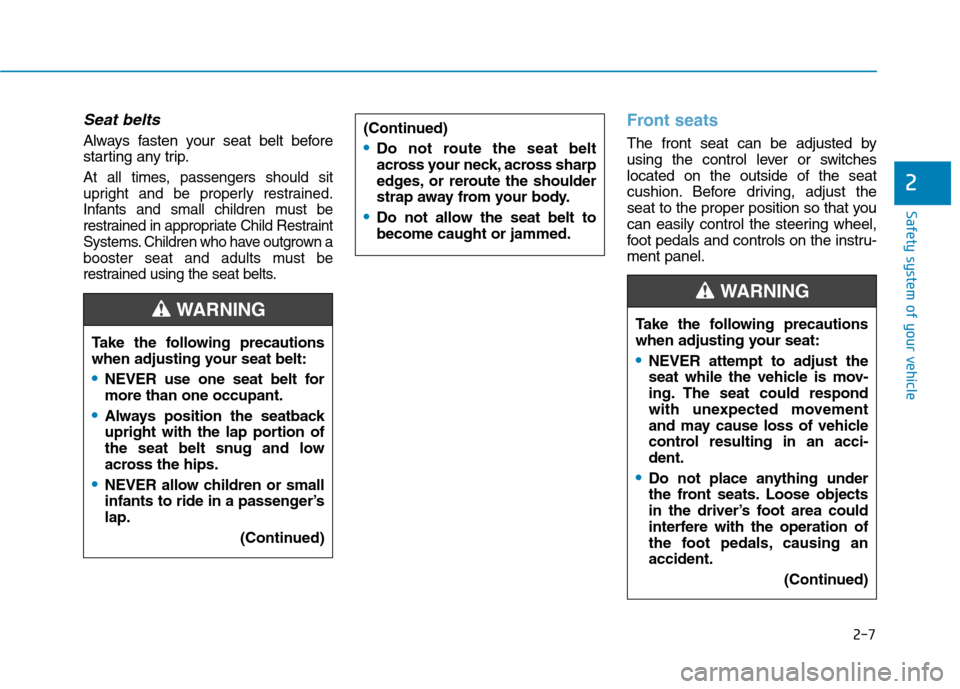
2-7
Safety system of your vehicle
2
Seat belts
Always fasten your seat belt before
starting any trip.
At all times, passengers should sit
upright and be properly restrained.
Infants and small children must be
restrained in appropriate Child Restraint
Systems. Children who have outgrown a
booster seat and adults must be
restrained using the seat belts.
Front seats
The front seat can be adjusted by
using the control lever or switcheslocated on the outside of the seat
cushion. Before driving, adjust the
seat to the proper position so that you
can easily control the steering wheel,
foot pedals and controls on the instru-ment panel.
Take the following precautions
when adjusting your seat belt:
NEVER use one seat belt for more than one occupant.
Always position the seatback
upright with the lap portion of
the seat belt snug and low
across the hips.
NEVER allow children or small
infants to ride in a passenger’slap. (Continued)
(Continued)
Do not route the seat belt
across your neck, across sharp
edges, or reroute the shoulder
strap away from your body.
Do not allow the seat belt to become caught or jammed.
WARNING Take the following precautions
when adjusting your seat:
NEVER attempt to adjust the
seat while the vehicle is mov-
ing. The seat could respond
with unexpected movement
and may cause loss of vehicle
control resulting in an acci-dent.
Do not place anything under
the front seats. Loose objects
in the driver’s foot area could
interfere with the operation of
the foot pedals, causing anaccident.
(Continued)
WARNING
Page 114 of 582
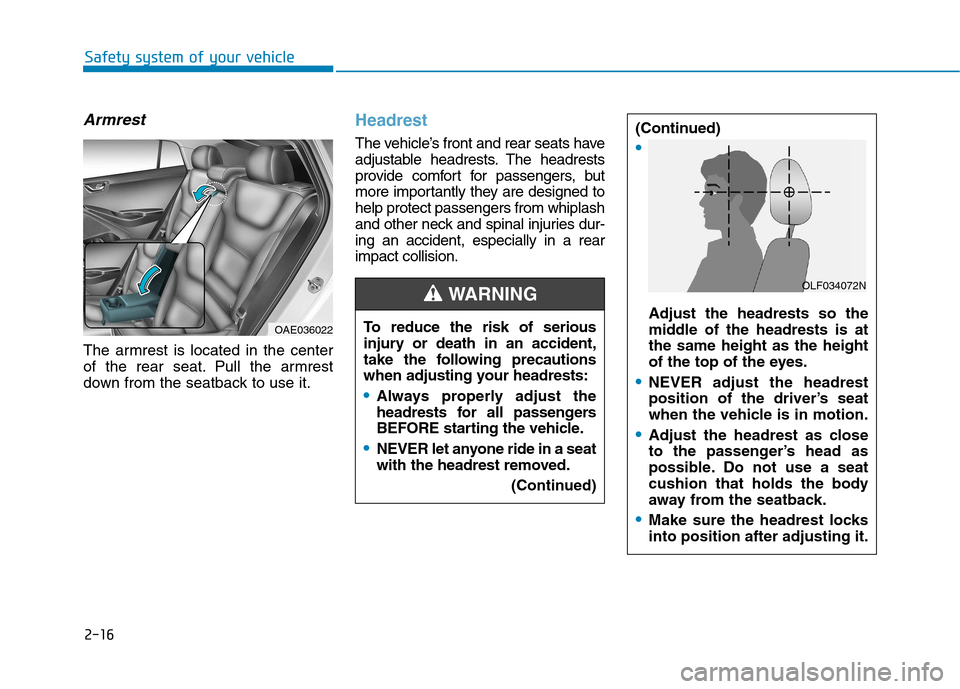
2-16
Safety system of your vehicle
Armrest
The armrest is located in the center
of the rear seat. Pull the armrest
down from the seatback to use it.
Headrest
The vehicle’s front and rear seats have
adjustable headrests. The headrests
provide comfort for passengers, but
more importantly they are designed tohelp protect passengers from whiplash
and other neck and spinal injuries dur-ing an accident, especially in a rearimpact collision.
OAE036022To reduce the risk of serious
injury or death in an accident,
take the following precautions
when adjusting your headrests:
Always properly adjust the
headrests for all passengers
BEFORE starting the vehicle.
NEVER let anyone ride in a seat
with the headrest removed.
(Continued)
(Continued)
Adjust the headrests so the
middle of the headrests is atthe same height as the height
of the top of the eyes.
NEVER adjust the headrest
position of the driver’s seat
when the vehicle is in motion.
Adjust the headrest as close
to the passenger’s head as
possible. Do not use a seat
cushion that holds the body
away from the seatback.
Make sure the headrest locks into position after adjusting it.
WARNING OLF034072N
Page 119 of 582
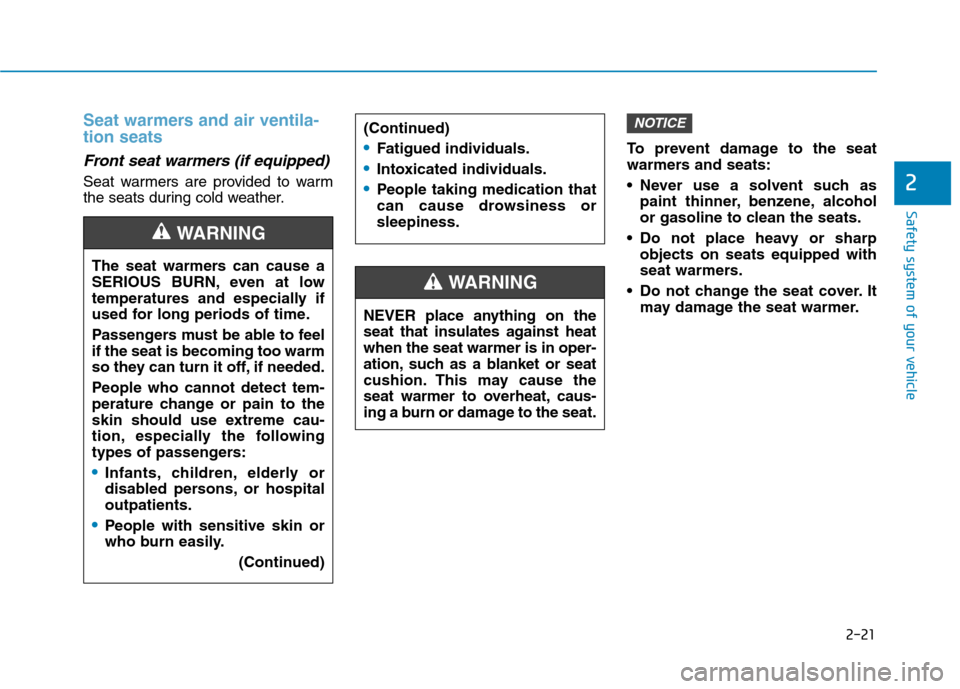
2-21
Safety system of your vehicle
2
Seat warmers and air ventila- tion seats
Front seat warmers (if equipped)
Seat warmers are provided to warm
the seats during cold weather.To prevent damage to the seat
warmers and seats:
Never use a solvent such as
paint thinner, benzene, alcohol
or gasoline to clean the seats.
Do not place heavy or sharp objects on seats equipped with
seat warmers.
Do not change the seat cover. It may damage the seat warmer.
NOTICE(Continued)
Fatigued individuals.
Intoxicated individuals.
People taking medication that
can cause drowsiness orsleepiness.
NEVER place anything on the
seat that insulates against heatwhen the seat warmer is in oper-
ation, such as a blanket or seat
cushion. This may cause the
seat warmer to overheat, caus-
ing a burn or damage to the seat.
WARNING
The seat warmers can cause a
SERIOUS BURN, even at low
temperatures and especially if
used for long periods of time.
Passengers must be able to feel if the seat is becoming too warm
so they can turn it off, if needed.
People who cannot detect tem-
perature change or pain to the
skin should use extreme cau-
tion, especially the following
types of passengers:
Infants, children, elderly or
disabled persons, or hospitaloutpatients.
People with sensitive skin or
who burn easily.
(Continued)
WARNING
Page 125 of 582
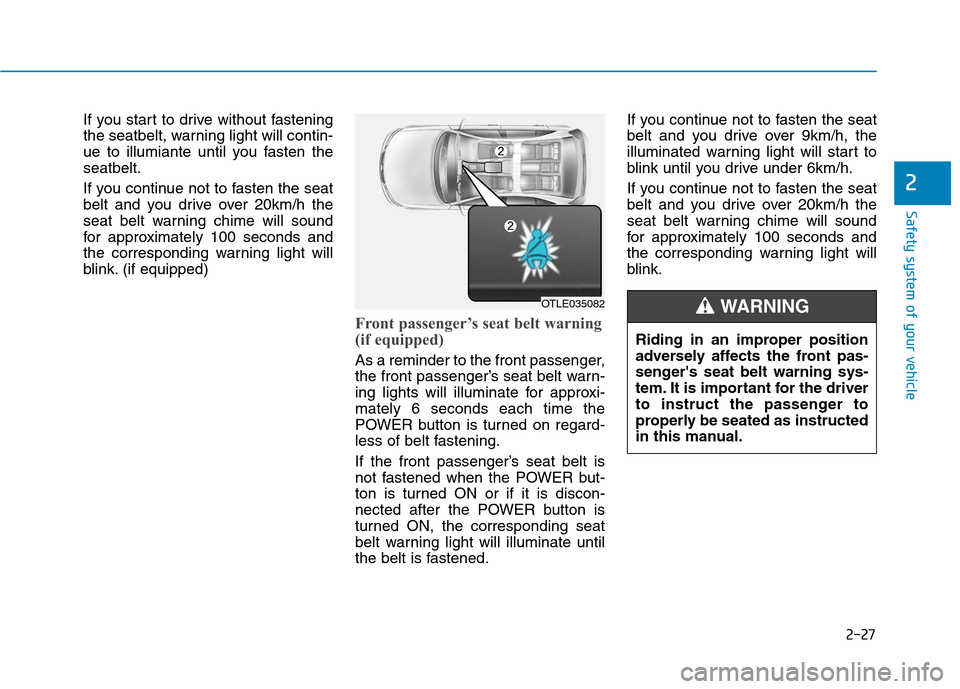
2-27
Safety system of your vehicle
2
If you start to drive without fastening
the seatbelt, warning light will contin-
ue to illumiante until you fasten theseatbelt.
If you continue not to fasten the seat
belt and you drive over 20km/h the
seat belt warning chime will sound
for approximately 100 seconds and
the corresponding warning light will
blink. (if equipped)
Front passenger’s seat belt warning
(if equipped)
As a reminder to the front passenger,
the front passenger’s seat belt warn-
ing lights will illuminate for approxi-mately 6 seconds each time the
POWER button is turned on regard-
less of belt fastening.
If the front passenger’s seat belt is
not fastened when the POWER but-
ton is turned ON or if it is discon-
nected after the POWER button is
turned ON, the corresponding seat
belt warning light will illuminate until
the belt is fastened.If you continue not to fasten the seat
belt and you drive over 9km/h, the
illuminated warning light will start to
blink until you drive under 6km/h.
If you continue not to fasten the seat
belt and you drive over 20km/h the
seat belt warning chime will sound
for approximately 100 seconds and
the corresponding warning light will
blink.
Riding in an improper position
adversely affects the front pas-
senger's seat belt warning sys-
tem. It is important for the driver
to instruct the passenger to
properly be seated as instructed
in this manual.
WARNING OTLE035082
Page 126 of 582
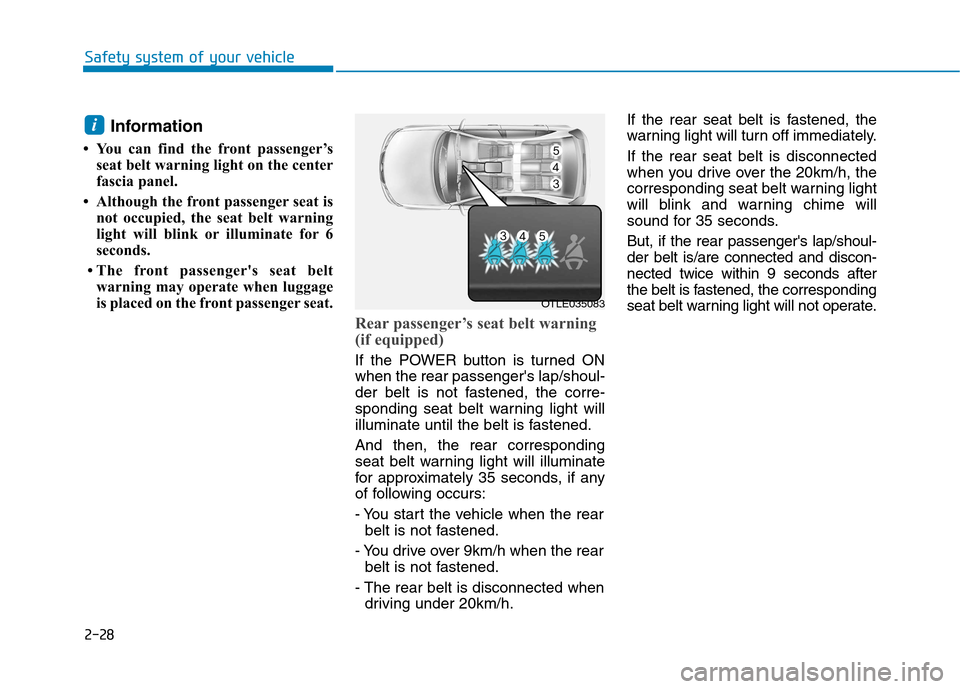
2-28
Safety system of your vehicle
Information
You can find the front passenger’s seat belt warning light on the center
fascia panel.
Although the front passenger seat is not occupied, the seat belt warning
light will blink or illuminate for 6
seconds.
The front passenger's seat belt warning may operate when luggage
is placed on the front passenger seat.
Rear passenger’s seat belt warning
(if equipped)
If the POWER button is turned ON when the rear passenger's lap/shoul-
der belt is not fastened, the corre-
sponding seat belt warning light will
illuminate until the belt is fastened. And then, the rear corresponding
seat belt warning light will illuminate
for approximately 35 seconds, if any
of following occurs:
- You start the vehicle when the rear belt is not fastened.
- You drive over 9km/h when the rear belt is not fastened.
- The rear belt is disconnected when driving under 20km/h. If the rear seat belt is fastened, the
warning light will turn off immediately. If the rear seat belt is disconnected
when you drive over the 20km/h, the
corresponding seat belt warning light
will blink and warning chime will
sound for 35 seconds. But, if the rear passenger's lap/shoul- der belt is/are connected and discon-nected twice within 9 seconds after
the belt is fastened, the corresponding
seat belt warning light will not operate.
i
OTLE035083
Page 138 of 582
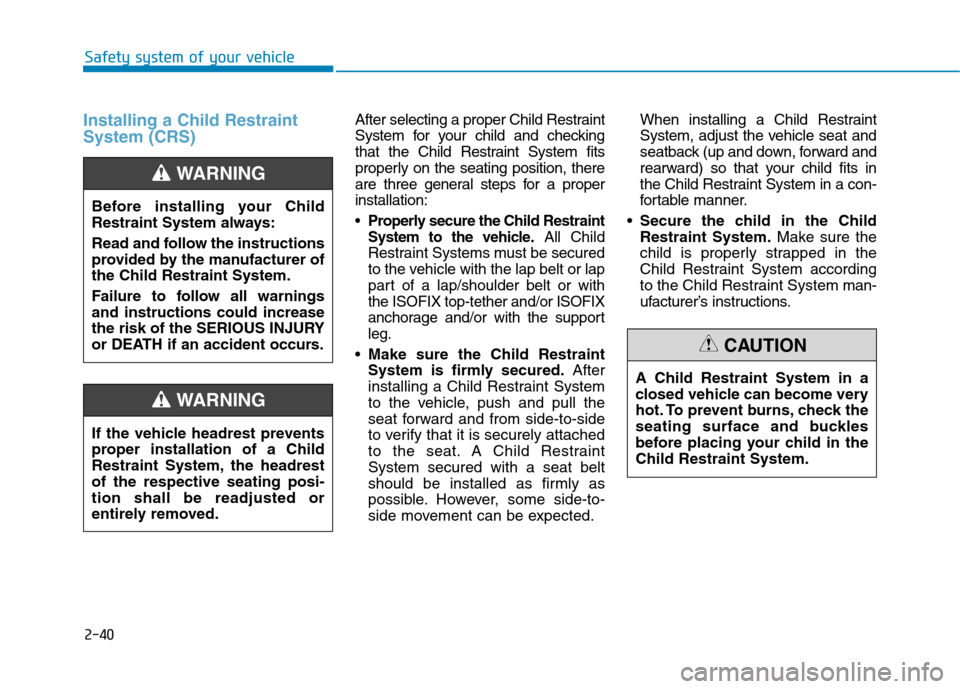
2-40
Safety system of your vehicle
Installing a Child Restraint System (CRS)After selecting a proper Child Restraint
System for your child and checking
that the Child Restraint System fits
properly on the seating position, there
are three general steps for a properinstallation:
Properly secure the Child Restraint
System to the vehicle.
All Child
Restraint Systems must be secured
to the vehicle with the lap belt or lap
part of a lap/shoulder belt or withthe ISOFIX top-tether and/or ISOFIX
anchorage and/or with the supportleg.
Make sure the Child Restraint
System is firmly secured. After
installing a Child Restraint System
to the vehicle, push and pull the
seat forward and from side-to-side
to verify that it is securely attached
to the seat. A Child RestraintSystem secured with a seat belt
should be installed as firmly as
possible. However, some side-to-
side movement can be expected. When installing a Child Restraint
System, adjust the vehicle seat and
seatback (up and down, forward and
rearward) so that your child fits in
the Child Restraint System in a con-
fortable manner.
Secure the child in the ChildRestraint System. Make sure the
child is properly strapped in the
Child Restraint System according
to the Child Restraint System man-
ufacturer’s instructions.
Before installing your Child
Restraint System always:
Read and follow the instructions
provided by the manufacturer ofthe Child Restraint System.
Failure to follow all warnings and instructions could increase
the risk of the SERIOUS INJURY
or DEATH if an accident occurs.
WARNING
If the vehicle headrest prevents
proper installation of a Child
Restraint System, the headrestof the respective seating posi-tion shall be readjusted or
entirely removed.
WARNING
A Child Restraint System in a
closed vehicle can become very
hot. To prevent burns, check the
seating surface and buckles
before placing your child in theChild Restraint System.
CAUTION
Page 154 of 582
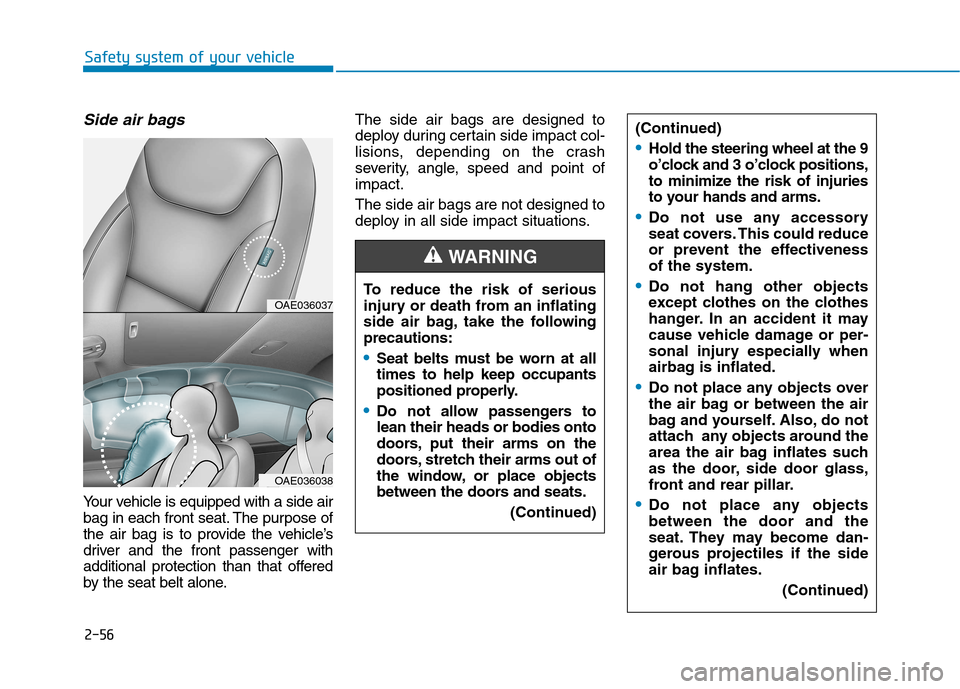
2-56
Safety system of your vehicle
Side air bags
Your vehicle is equipped with a side air
bag in each front seat. The purpose of
the air bag is to provide the vehicle’s
driver and the front passenger with
additional protection than that offered
by the seat belt alone.The side air bags are designed to
deploy during certain side impact col-
lisions, depending on the crash
severity, angle, speed and point ofimpact. The side air bags are not designed to
deploy in all side impact situations.
To reduce the risk of serious
injury or death from an inflating
side air bag, take the follo wing
precautions:
Seat belts must be worn at all times to help keep occupants
positioned properly.
Do not allow passengers to lean their heads or bodies onto
doors, put their arms on the
doors, stretch their arms out of
the window, or place objects
between the doors and seats.
(Continued)
WARNING
OAE036037
OAE036038
(Continued)
Hold the steering wheel at the 9
o’clock and 3 o’clock positions,
to minimize the risk of injuries
to your hands and arms.
Do not use any accessory
seat covers. This could reduce
or prevent the effectivenessof the system.
Do not hang other objects
except clothes on the clothes
hanger. In an accident it may
cause vehicle damage or per-
sonal injury especially when
airbag is inflated.
Do not place any objects over
the air bag or between the air
bag and yourself. Also, do not
attach any objects around the
area the air bag inflates such
as the door, side door glass,
front and rear pillar.
Do not place any objects between the door and the
seat. They may become dan-
gerous projectiles if the side
air bag inflates.(Continued)
Page 156 of 582
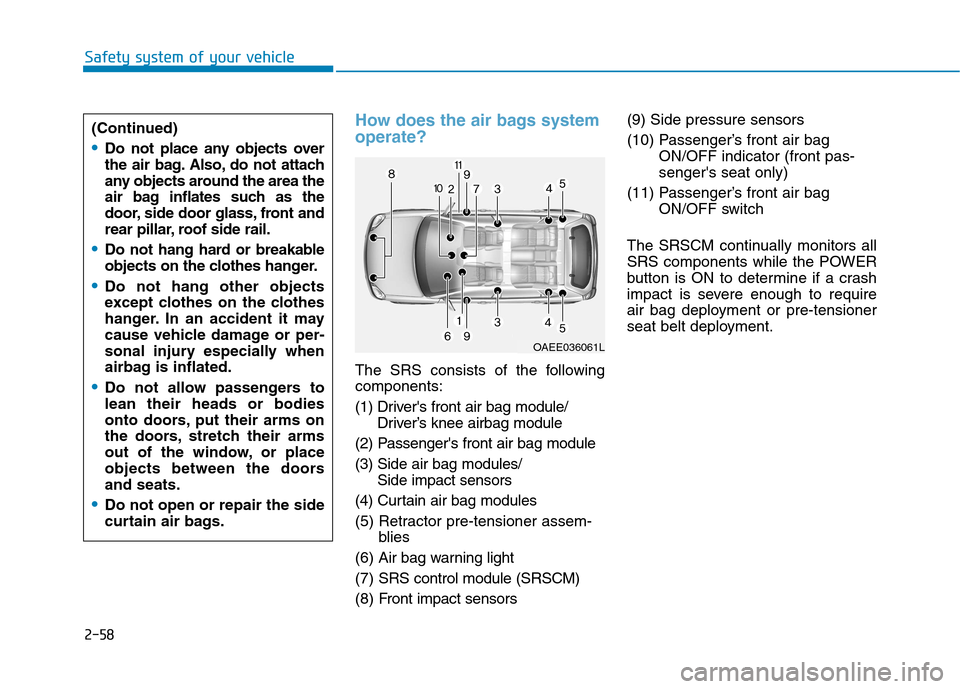
2-58
Safety system of your vehicle
How does the air bags system operate?
The SRS consists of the following components:
(1) Driver's front air bag module/Driver’s knee airbag module
(2) Passenger's front air bag module
(3) Side air bag modules/ Side impact sensors
(4) Curtain air bag modules
(5) Retractor pre-tensioner assem- blies
(6) Air bag warning light
(7) SRS control module (SRSCM)
(8) F ront impact sensors (9) Side pressure sensors
(10) Passenger’s front air bag
ON/OFF indicator (front pas- senger's seat only)
(11) Passenger’s front air bag ON/OFF switch
The SRSCM continually monitors all
SRS components while the POWER
button is ON to determine if a crash
impact is severe enough to require
air bag deployment or pre-tensioner
seat belt deployment.
(Continued)
Do not place any objects over
the air bag. Also, do not attach
any objects around the area the
air bag inflates such as the
door, side door glass, front and
rear pillar, roof side rail.
Do not hang hard or breakable
objects on the clothes hanger.
Do not hang other objects
except clothes on the clothes
hanger. In an accident it may
cause vehicle damage or per-
sonal injury especially when
airbag is inflated.
Do not allow passengers to lean their heads or bodies
onto doors, put their arms on
the doors, stretch their arms
out of the window, or place
objects between the doorsand seats.
Do not open or repair the side
curtain air bags.
OAEE036061L